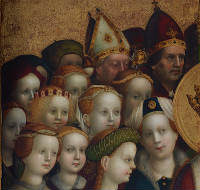Heads of the companions and the pope
The drawing of the many heads of the companions, with their highly ornate hair-dos, garlands, diadems and crowns, comes across as free and confident. A variously dense network of parallel and cross-hatching defines not only the distribution of light and shade, but also the plasticity of the forms by virtue of the arc-like shapes of many lines, which are sometimes continued as stippled lines and thus generate soft transitions between light and dark. These faces with roughly drawn eye orbits and briefly sketched eyebrows, noses and mouths differ from the detailed underdrawing of the face of the pope. Here, not only are the nose, mouth and chin drawn in detail, but also the wrinkles in the brow, around the eyes and on the cheek. Particularly around the mouth and chin, individual lines give the impression of a searching for form, which could point to this being a portrait of an actual person.
What we see in the painted version is not only a frequent shift of contours and internal drawing lines in the faces, but above all a drastic reduction and simplification of the jewellery and other ornaments. The diminution, or indeed total removal of whole elements of the headdresses has led in many cases to more enlarged and more visible faces. As this is not true of all the companions, however, increased visibility of the faces was probably not the main reason for the wide-ranging reduction of the headdresses in the painted version.
details & results
projekt von:















